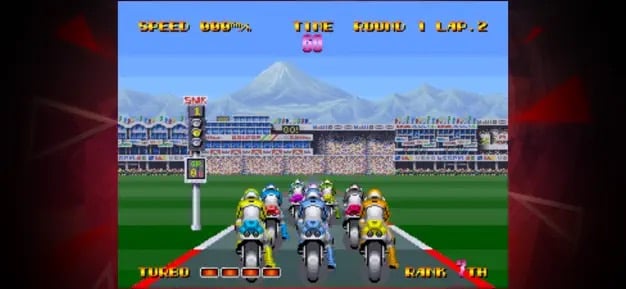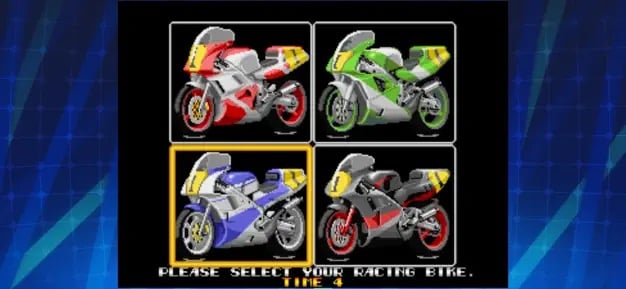I’m starting to think my hunch was correct about the pattern of Hamster and SNK’s ACA NEOGEO releases. Having covered most of the big hits from across the system’s lifespan, they’re now going back and filling out the catalog in a loose chronological fashion. Riding Hero ($3.99) is another early NEOGEO game, and like many of its peers it’s trying to offer an alternative to a popular hit of the era. In this case, it’s SEGA’s Hang-On series of motorcycle racers, which tore up the arcades and home consoles with its fast gameplay and stellar visuals. Unfortunately, Riding Hero suffers a similar fate to other near-launch NEOGEO games. It’s just not all that good.
This is another game that arrived shortly after the Japanese launch of the MVS but made it in time for the North American one. It actually makes use of some of the console’s features that didn’t see a whole lot of play in some regions, and I certainly can’t say there wasn’t an attempt made here. The NEOGEO could take memory cards, in theory allowing one to save their progress and return to it on any other NEOGEO unit. Not really necessary for most games, since they were arcade games and tended to be fairly short affairs. And frankly, I can’t imagine too many people stumped for one of those devices specifically to use with the arcade units. But Riding Hero had support for the memory card, and in this case it was rather important for one of its three modes.

It also had support for another curious feature, and in this case it was actually the first game to do so. If an arcade operator had two NEOGEO cabinets, one could connect a cable between them to play this game’s head-to-head versus mode. This support also extended to the later home version. Naturally, very few arcade operators had two NEOGEO cabinets. The whole point was that you could just have one and change the games in it. But the feature was there, and Riding Hero was the pioneering use of it. If Riding Hero had been a better game, perhaps it would have seen arcade operators buying extra cabinets to take advantage of this feature.
Sadly, Riding Hero isn’t a better game. It has one really cool idea, and that idea is the only reason it’s worth considering today. Otherwise, everything about it ranges from middling to poor. On a technical level, it barely passes. It looks worse than SEGA’s motorcycle racer from three years before, and not by a little. But hey, high bar there. It’s not the worst-looking early NEOGEO game by any means. I don’t think it did the new system any favors in terms of selling its graphical muscle, but it probably didn’t hurt it too much either.
It’s the gameplay mechanics where things really run into trouble. The handling of your bike isn’t too bad, albeit with a bit of lag that takes some getting used to, but games like this can easily go awry based on your interactions with other racers and objects. The collision in Riding Hero is an absolute nightmare. If you get anywhere near anything, you’ll bounce, go into a spin, or crash. Fair is fair, but this can happen even if rival bikers hit you from behind, something you can’t possibly see coming. Crash recoveries take so long that any wipeout can almost completely knock you out of a race. You have a limited Turbo you can use, but because the course map isn’t displayed you never know when it’s safe to fire it off. The CPU rubber bands like wild, too. It’s infuriating to play, and it feels like no amount of practice is enough to overcome some of this nonsense.

So, let’s talk about the modes of play. First of all, that versus mode is right off the table. You can’t link systems here, so you can’t access any multiplayer. That leaves you with the Grand Prix mode and the Story mode. The former is a standard affair. You choose your favorite bike and race against other bikers on a variety of courses, and you need to not only stay ahead of the timer but also finish in the top three to move on. There are several other bikers on the road with you, so you really need to be careful you don’t get hit from the rear. Fail to place, and it’s a game over. Win enough times and you’ll become the champion. Good luck with that.
The Story mode is the one saving grace of this game. It’s the one truly interesting thing in the game, and if a person was to somehow fall in love with Riding Hero it would be for this. You don’t see this kind of thing in arcade games very often, and it’s really only due to the memory card feature of the system that it can be here. In this mode, you take on the role of a young rider who wants to break into the street bike racing scene and eventually participate in the Suzuka 8 Hours Endurance race. You’ll have to work your way up by competing against other bikers for money, which you can use to upgrade your ride and eventually pay the entry fee to the big race. These races are typically one-on-one, but unlike in Grand Prix mode, there is other vehicle traffic on the road. Swings and roundabouts. The cars are annoying and you will constantly hit them, but you have less concern about getting rear-ended.

It’s such an odd thing to have in an arcade racer. You have a map you can move around on. There are characters to talk to, with a fair bit of dialogue. You can also return to your home, which is where you would have used your memory card in the original machine. There’s actually a degree of non-linearity here, and if one wanted to be very generous with the term you could almost call this RPG-ish. So yes, this is the system’s only motorcycle racing game and arguably one of the few things on the system that could be kind-of-sort-of called an RPG. That certainly makes it of historical note, and it might just be the hook for some of you.
I just wish the actual gameplay was less irritating, because the Story mode is a really cool feature that makes this stand out among other ACA NEOGEO offerings. But the game itself just isn’t very fun, and there’s only so much that fancy lipstick can do for a pig of this nature. The mechanical issues are only made worse if you’re playing with touch controls. There’s just no margin for error here given everything that is stacked against you, and the virtual stick is enough to push things over the red line. If you’re going to play this, you should take advantage of the support for external controllers. Give yourself a fighting chance.

You get all of the usual Arcade Archives stuff here. Both Japanese and overseas versions of the game, and you’ll likely want to stick to the overseas one unless you can read Japanese. There are also High Score and Caravan modes with online leaderboards, though this game isn’t exactly set up for either of those to be much fun. The gameplay options are quite nice here, allowing you to tweak the difficulty and time limits a bit to make the game more tolerable. Be the kind arcade operator we all wish we had back in the day. The emulation is of good quality, of course. I probably don’t need to say that in these reviews at this point, but whatever.
There’s assuredly room on mobile for another arcade-style motorcycle racer, especially a one-and-done purchase. But Riding Hero is almost impossible to enjoy as a pick-up-and-play experience thanks to its frustrating gameplay, so that’s right out. The Story mode is more interesting to poke at, and if you are willing to put up with… well, the game itself, you’ll find a rather unique experience in what Riding Hero has to offer. Not a good game overall, but it is in some ways a fascinating one, and that might be enough for your money if you have the right inclinations.
